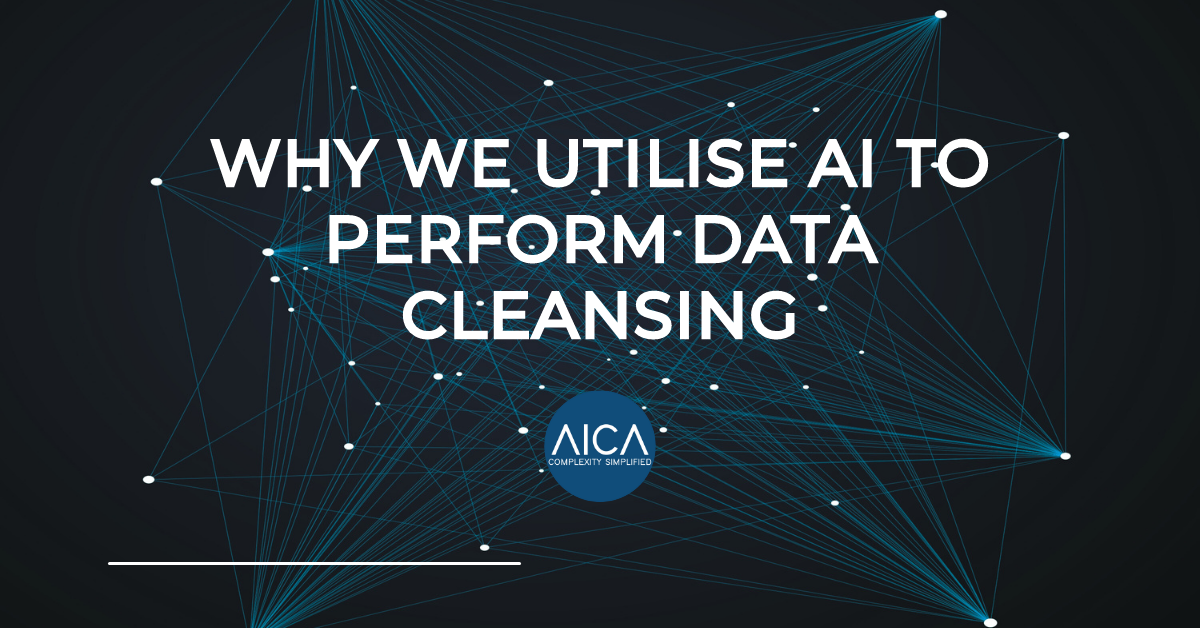In the age of digital transformation, vast amounts of data are being generated every second. As businesses and organisations become more data-driven, the quality and reliability of this data have taken centre stage. Herein lies the significance of data cleansing, and increasingly, the use of Artificial Intelligence (AI) to facilitate this process.
In this article, we will give you an overview of data cleansing, as well as explain why AICA utilises AI to perform data cleansing for our clients.
Firstly, What is Data Cleansing?
Data cleansing, often also referred to as data cleaning or data scrubbing, is the process of detecting and correcting or removing errors and inconsistencies in data. This process is carried out to improve the quality of data, ensuring that it is accurate, consistent and usable. Data cleansing involves various tasks, including:
– Removing duplicates: Identifying and eliminating duplicate records to prevent redundancy.
– Validating and correcting values: Ensuring data is accurate and adhering to specific standards or formats.
– Filling in missing values: Identifying gaps in data and, if possible, filling or marking those gaps.
– Correcting format inconsistencies: Making sure that data is consistent in terms of format, such as date formats or capitalisation.
– Identifying and handling outliers: Detecting data points that significantly deviate from other observations.
Importance of Data Cleansing
– Ensures Decision-making Accuracy: Decisions made based on unclean data can lead to misguided strategies, impacting your business’s bottom line. Clean data ensures that the insights derived are accurate and actionable.
– Improves Operational Efficiency: Clean data reduces the risk of errors in your operational processes. It ensures smooth data flow and processing, leading to better business efficiency.
– Enhances Data Quality: The primary goal of data cleansing is to uplift the quality of data. High-quality data leads to better analytics, forecasts and business intelligence.
– Reduces Costs: Errors in data can lead to financial losses in various ways, from wrong business decisions to unnecessary postal charges for incorrect addresses. A rigorous data cleansing process can mitigate these unnecessary costs.
– Ensures Compliance: In industries where regulations require maintenance of accurate records, data cleansing becomes critical to ensure that businesses stay compliant and avoid potential legal implications.
Here’s Why AI Has Become a Go-To Solution For Ensuring Data Quality.
1. Scale and Complexity of Modern Data
Data today isn’t just voluminous; it’s multifaceted and complex. Traditional manual data cleaning methods can be painstakingly slow and often ineffective when dealing with the massive datasets of the modern era. AI, with its ability to process vast amounts of information at lightning speed, can handle the scale and complexity of this data with relative ease.
2. Enhanced Accuracy and Prediction
One of the primary reasons to clean data is to ensure the accuracy of subsequent analyses. Clean data results in more accurate machine learning predictions and analyses. Using AI for data cleansing means not only are errors identified and rectified more efficiently, but the AI itself can learn over time to predict where errors might occur, thus preemptively addressing issues.
3. Dynamic Nature of Data
As mentioned earlier, data is continually changing. Manual cleaning processes might not capture real-time variations in data, leading to outdated or irrelevant datasets. AI-driven data cleansing tools can be designed to continuously monitor and clean data in real time, ensuring that data sets remain current and relevant.
4. Cost Efficiency
Mistakes in data can be costly. Whether it’s misguided business strategies or missed opportunities, poor data quality can have significant financial implications. AI-driven data cleansing can help reduce these risks by providing more accurate, consistent and timely data quality checks.
5. Addressing a Variety of Data Issues
Data cleansing isn’t just about removing duplicates or correcting formatting errors. It’s about identifying outliers, normalising and standardising data, and ensuring that the data aligns with the specific requirements of a project or analysis. Our AI is trained to recognise a wide range of data issues and can be equipped with a suite of tools to address each unique problem.
6. Continuous Learning and Adaptability
One of the standout features of AI is its ability to learn. With every iteration of data cleansing, the AI system can improve its processes, adapting to new data structures, sources or business requirements. This ensures that the system remains efficient and effective, even as the nature of the data it’s cleaning evolves.
In conclusion
While traditional data cleansing methods have their place, the advantages of AI in this realm are hard to ignore. As data continues to play an increasingly central role in our business and personal lives, tools and technologies that ensure its quality will be indispensable. AI, with its scalability, efficiency and adaptability, is poised to lead this charge.
To find out more, contact AICA today.

